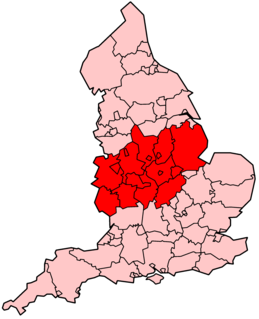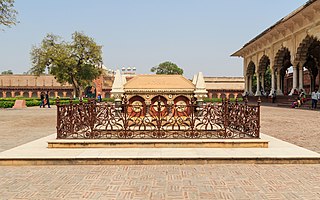Related Research Articles

Warren Hastings, an English statesman, was the first Governor of the Presidency of Fort William (Bengal), the head of the Supreme Council of Bengal, and so the first de facto Governor-General of Bengal in 1772–1785. He and Robert Clive are credited with laying the foundation of the British Empire in India. He was an energetic organizer and reformer. In 1779–1784 he led forces of the East India Company against a strong coalition of native states and the French. Finally, the well-organized British coalition held its own, while France lost influence in India. In 1787, he was accused of corruption and impeached, but after a long trial acquitted in 1795. He was made a Privy Councillor in 1814.

Henry Thomas Cockburn of Bonaly, Lord Cockburn was a Scottish lawyer, judge and literary figure. He served as Solicitor General for Scotland between 1830 and 1834.

The Midlands is the central part of England and a cultural area that broadly corresponds to the Kingdom of Mercia of the Early Middle Ages. The Midlands region is bordered by Northern England and Southern England. The Midlands were important in the Industrial Revolution of the 18th and 19th centuries. Two of the nine official regions of England are the West Midlands and East Midlands. Birmingham, in the West Midlands, is the second-largest city and metropolitan area in the United Kingdom.

Henry Somerset, 5th Duke of Beaufort was an English courtier and politician. He was the only son of Charles Noel Somerset, 4th Duke of Beaufort and Elizabeth Somerset, Duchess of Beaufort. Styled Marquess of Worcester from 1746, at his father's death on 28 October 1756, he succeeded him as 5th Duke of Beaufort, 7th Marquess of Worcester, 11th Earl of Worcester, and 13th Baron Herbert.

General Lord Robert Edward Henry Somerset was a British soldier who fought during the Peninsular War and the War of the Seventh Coalition.
Captain John Lyons, was a British owner of extensive sugar plantations, of 563 acres in total, in Antigua, where he served as a politician and a Captain in the Royal Navy.

Henry Charles Somerset, 6th Duke of Beaufort, KG, styled Marquess of Worcester until 1803, was a British politician.

John Henry Manners, 5th Duke of Rutland KG, styled Lord Roos from 1778 until 1779 and Marquess of Granby from 1779 until 1787, was a British landowner as well as an owner and breeder of Thoroughbred racehorses.

Henry Piddington was an English sea captain who sailed in East India and China and later settled in Bengal where he worked as a curator of a geological museum and worked on scientific problems, and is particularly well known for his pioneering studies in meteorology of tropical storms and hurricanes. He noted the circular winds around a calm centre recorded by ships caught in storms and coined the name cyclone in 1848.
William Barwell (1709–1769) was an administrator of the English East India Company.
Sir Mark Wood, 1st Baronet was a British army officer and engineer. He was a Member of Parliament (MP) for Milborne Port, Gatton and Newark. He received a baronetcy on 3 October 1808.

The Colvin family, for the purposes of this article, is that group of people descended from James Colquhoun Colvin (1767–1847), the son of Alexander Colvin (1718–1791) and Elizabeth 'Bettie' née Kennedy (1714–1795). James was a merchant trading between London and Calcutta during the East India Company. This Anglo-Indian family was intimately involved with the British Raj, first as traders and then as administrators and soldiers. Their descendants continued in service to the British Empire and later in some of its constituent countries.

Richard Barwell was an early trader with the East India Company and amassed one of the largest fortunes in early British India.
Sir George Abercrombie Robinson, 1st Baronet was a British MP and Chairman of the East India Company.
Henry Cockburn was a British diplomat.
Sir Charles Cockerell, 1st Baronet was a Somerset-born Englishman who prospered as an official of the East India Company (EIC) and became a politician. He sat in the House of Commons for most of the period between 1802 and 1837, sitting for five different constituencies.
William Moffat was an English banker, merchant and politician.
Sir William Bensley was launched in 1802 as an East Indiaman for the British East India Company (EIC). Between 1802 and 1813 she made six voyages for the EIC. Her owners sold her and she became a transport. During this time she repelled an American privateer in a single-ship action. She made one voyage transporting convicts to New South Wales (1816–1817). She continued to trade until 1841 when she wrecked at Nova Scotia.

General Thomas Hooke Pearson was a senior British Army general.
Nathaniel Middleton (1750–1807) was a civil servant of the British East India Company, closely involved with Warren Hastings and his dealings with the Nawab of Awadh during the 1770s, and later a principal witness at Hastings's trial.
References
- ↑ Volume 37 (1844). "Accounts and Papers of the House of Commons" . Retrieved June 6, 2018.
- 1 2 3 4 Crisp, Frederick Arthur, ed. (1911). Notes to the Visitation of England and Wales. 9. pp. 91–93.
- 1 2 Crisp, Frederick Arthur, ed. (1902). Visitation of England and Wales. 10. pp. 73–77.
- 1 2 Volume 16 (1841). "The Gentleman's Magazine" . Retrieved June 5, 2018.
- ↑ "Pearson, John, 1771-1841" . Retrieved June 6, 2018.